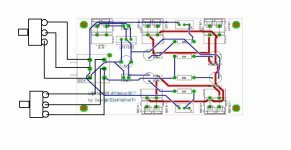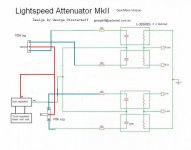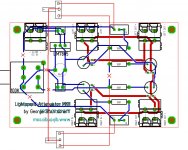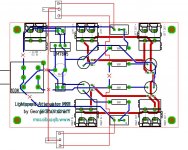I am using board from group buy http://www.diyaudio.com/forums/group-buys/153388-optical-volume-control-professional-pcb.html
Is connection shown correct
Is connection shown correct
Attachments
This is much more confusing than just a doing stereo version.
So there is no way of using the single board in a dual mono configuration ?
I believe that is what BFNY was trying to explain to me previously.
Yes you can but you'll have to look at it closely and cut some tracks. If you post the circuit board only up track side, I will nut it out for you and put on the 2 x single 100k log pots. And post it back up.
Cheers George
Last edited:
Here it is done quicky, there are 5 cuts to make, and your calibration trimpots are still in the circuit should you need them, if the ldr's are properly quad matched you should bridge them out now that you have L&R volume controls. Like I said I did this quickly so shoot me if there are any mistakes.
Cheers George
Cheers George
Attachments
No it is not, look and follow my diagram, the 5v constant goes to the wiper (center tap) yours is not the same.
With reference to the schematic 5/100 = how much current ? across 1 LDR
The 5vdc is controled by the 100k dual pot, that gives varible (give and take) voltage to the leds, which in turn varies the resistance of the LDR's.
Cheers George
with reference to the schematic,5/100k = how much current ? across the LDR's
Yes.. the answer is potentiometers and set resistors are ohmic devices, hence any voltage divided by that resistance creates that amount of current. Simply using a potentiometer creates a variable ohmic current and is guessing that a NSL32SR2 may work. The Silonex NSL32SR2 gets on with its function and certainly tolerates the overtly simple use of DC being supplied by a fixed voltage and then current being across that ohmic part. But why live to tolerate, its far better to acknowledge these shortcomings and explore other ways for their use to deliver exceptional low distortion in audio use.
NSL32SR2 create a electronics contradiction if the thinking to make them perform extends no further than a voltage and potentiometer. and other ... which is ample evident here on this post. The contradiction if just using these simple parts is maintaining current across the variable part of that resistance.... so to step well beyond that.
To start performing they require not 5v, but voltage below 2.5v, lower even better still, and current to be maintained, allowable by sharing amongst devices.
I see none of these criteria being met here by using trim pots, high value potentiometers, set resistors and regulated 5v...to approach the proper and real capabilities of the Silonex NSL32SR2
Cheers / Chris
NSL32SR2 create a electronics contradiction if the thinking to make them perform extends no further than a voltage and potentiometer. and other ... which is ample evident here on this post. The contradiction if just using these simple parts is maintaining current across the variable part of that resistance.... so to step well beyond that.
To start performing they require not 5v, but voltage below 2.5v, lower even better still, and current to be maintained, allowable by sharing amongst devices.
I see none of these criteria being met here by using trim pots, high value potentiometers, set resistors and regulated 5v...to approach the proper and real capabilities of the Silonex NSL32SR2
Cheers / Chris
I don't even understand what Chris is talking about. The voltage used to control volume does not go through the signal part of the LDRs. Are we bringing a different circuit into discussion? If so, it probably would more appropriately go into another thread.
I do have a question about the log pots, how well do they normally track each other?
I do have a question about the log pots, how well do they normally track each other?
Last edited:
I don't even understand what Chris is talking about. The voltage used to control volume does not go through the signal part of the LDRs. Are we bringing a different circuit into discussion? If so, it probably would more appropriately go into another thread.
I do have a question about the log pots, how well do they normally track each other?
I am discussing the DC side, of the NSL32SR2. and the benefits of voltage lower than 2.5v and maintaining current, the latter in particular that cannot be achieved with large value variable potentiometers, trim pots or fixed resistors. NSL32SR2 really starts to perform for low distortion audio purpose when voltage is low and current is maintained, as my post inferred normally a contradiction if thinking inside the square with potentiometers etc. But as I have proven can be overcome.
Cheers / Chris
Last edited:
I am discussing the DC side, of the NSL32SR2. and the benefits of voltage lower than 2.5v and maintaining current, the latter in particular that cannot be achieved with large value variable potentiometers, trim pots or fixed resistors. NSL32SR2 really starts to perform for low distortion audio purpose when voltage is low and current is maintained, as my post inferred normally a contradiction if thinking inside the square with potentiometers etc. But as I have proven can be overcome.
Cheers / Chris
I'm also using current control, works well. Playing now with parameters. I see no reason to go above 2.5ma at any time, and get about 100dB of control. Circuits can be very simple, but I'm not getting naked first here.
Also looking at distortion of the LDR's, which is not bad if levels are not insane.
But, what about the load on upstream electronics? It can be very low by traditional standards - low of maybe 500ohms to 1k. This may cause the upstream device to also distort, right?
Can you get -60db of attenuation?I'm also using current control, works well. Playing now with parameters. I see no reason to go above 2.5ma at any time, and get about 100dB of control. Circuits can be very simple, but I'm not getting naked first here.
Also looking at distortion of the LDR's, which is not bad if levels are not insane.
But, what about the load on upstream electronics? It can be very low by traditional standards - low of maybe 500ohms to 1k. This may cause the upstream device to also distort, right?
Can you get -60db of attenuation?
yes, but when you use a standard 270 degree rotation log pot, the amount of control at those levels is not "fine" -i.e. 1-2 degrees rotation = maybe 5-10dB attenuation. But great for low level listening. At these incredibly low levels the channel match can be off a bit, so I would always include a balance control.
The reason you can get down that low, is with current control the top series LDR resistor can go to values in the 10Mohm range, over the bottom shunt, which is at say 150 ohms.
So it goes all the way down to zero level out, which on my test gear dips below the -100dB mark, (with full volume = 0dB)
- Home
- Source & Line
- Analog Line Level
- Lightspeed Attenuator a new passive preamp



